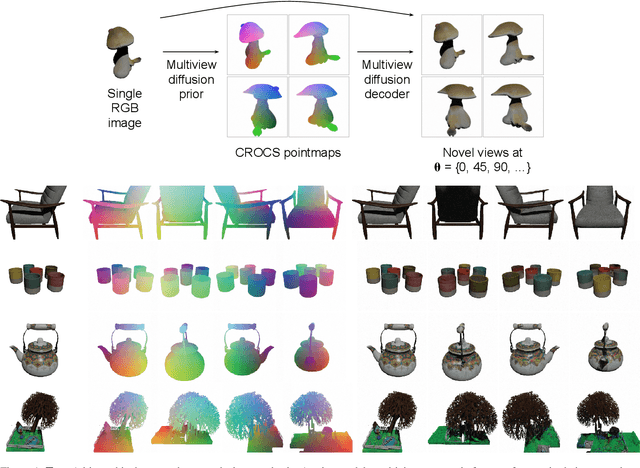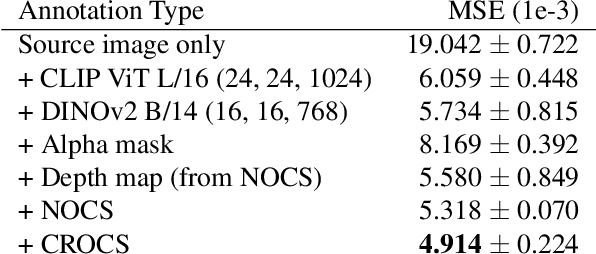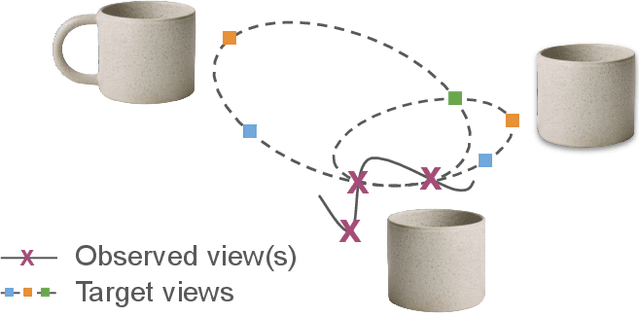Niloy J. Mitra
Hand-Shadow Poser
May 11, 2025Abstract:Hand shadow art is a captivating art form, creatively using hand shadows to reproduce expressive shapes on the wall. In this work, we study an inverse problem: given a target shape, find the poses of left and right hands that together best produce a shadow resembling the input. This problem is nontrivial, since the design space of 3D hand poses is huge while being restrictive due to anatomical constraints. Also, we need to attend to the input's shape and crucial features, though the input is colorless and textureless. To meet these challenges, we design Hand-Shadow Poser, a three-stage pipeline, to decouple the anatomical constraints (by hand) and semantic constraints (by shadow shape): (i) a generative hand assignment module to explore diverse but reasonable left/right-hand shape hypotheses; (ii) a generalized hand-shadow alignment module to infer coarse hand poses with a similarity-driven strategy for selecting hypotheses; and (iii) a shadow-feature-aware refinement module to optimize the hand poses for physical plausibility and shadow feature preservation. Further, we design our pipeline to be trainable on generic public hand data, thus avoiding the need for any specialized training dataset. For method validation, we build a benchmark of 210 diverse shadow shapes of varying complexity and a comprehensive set of metrics, including a novel DINOv2-based evaluation metric. Through extensive comparisons with multiple baselines and user studies, our approach is demonstrated to effectively generate bimanual hand poses for a large variety of hand shapes for over 85% of the benchmark cases.
MonetGPT: Solving Puzzles Enhances MLLMs' Image Retouching Skills
May 09, 2025Abstract:Retouching is an essential task in post-manipulation of raw photographs. Generative editing, guided by text or strokes, provides a new tool accessible to users but can easily change the identity of the original objects in unacceptable and unpredictable ways. In contrast, although traditional procedural edits, as commonly supported by photoediting tools (e.g., Gimp, Lightroom), are conservative, they are still preferred by professionals. Unfortunately, professional quality retouching involves many individual procedural editing operations that is challenging to plan for most novices. In this paper, we ask if a multimodal large language model (MLLM) can be taught to critique raw photographs, suggest suitable remedies, and finally realize them with a given set of pre-authored procedural image operations. We demonstrate that MLLMs can be first made aware of the underlying image processing operations, by training them to solve specially designed visual puzzles. Subsequently, such an operation-aware MLLM can both plan and propose edit sequences. To facilitate training, given a set of expert-edited photos, we synthesize a reasoning dataset by procedurally manipulating the expert edits and then grounding a pretrained LLM on the visual adjustments, to synthesize reasoning for finetuning. The proposed retouching operations are, by construction, understandable by the users, preserve object details and resolution, and can be optionally overridden. We evaluate our setup on a variety of test examples and show advantages, in terms of explainability and identity preservation, over existing generative and other procedural alternatives. Code, data, models, and supplementary results can be found via our project website at https://monetgpt.github.io.
SMF: Template-free and Rig-free Animation Transfer using Kinetic Codes
Apr 07, 2025Abstract:Animation retargeting involves applying a sparse motion description (e.g., 2D/3D keypoint sequences) to a given character mesh to produce a semantically plausible and temporally coherent full-body motion. Existing approaches come with a mix of restrictions - they require annotated training data, assume access to template-based shape priors or artist-designed deformation rigs, suffer from limited generalization to unseen motion and/or shapes, or exhibit motion jitter. We propose Self-supervised Motion Fields (SMF) as a self-supervised framework that can be robustly trained with sparse motion representations, without requiring dataset specific annotations, templates, or rigs. At the heart of our method are Kinetic Codes, a novel autoencoder-based sparse motion encoding, that exposes a semantically rich latent space simplifying large-scale training. Our architecture comprises dedicated spatial and temporal gradient predictors, which are trained end-to-end. The resultant network, regularized by the Kinetic Codes's latent space, has good generalization across shapes and motions. We evaluated our method on unseen motion sampled from AMASS, D4D, Mixamo, and raw monocular video for animation transfer on various characters with varying shapes and topology. We report a new SoTA on the AMASS dataset in the context of generalization to unseen motion. Project webpage at https://motionfields.github.io/
LIM: Large Interpolator Model for Dynamic Reconstruction
Mar 28, 2025



Abstract:Reconstructing dynamic assets from video data is central to many in computer vision and graphics tasks. Existing 4D reconstruction approaches are limited by category-specific models or slow optimization-based methods. Inspired by the recent Large Reconstruction Model (LRM), we present the Large Interpolation Model (LIM), a transformer-based feed-forward solution, guided by a novel causal consistency loss, for interpolating implicit 3D representations across time. Given implicit 3D representations at times $t_0$ and $t_1$, LIM produces a deformed shape at any continuous time $t\in[t_0,t_1]$, delivering high-quality interpolated frames in seconds. Furthermore, LIM allows explicit mesh tracking across time, producing a consistently uv-textured mesh sequence ready for integration into existing production pipelines. We also use LIM, in conjunction with a diffusion-based multiview generator, to produce dynamic 4D reconstructions from monocular videos. We evaluate LIM on various dynamic datasets, benchmarking against image-space interpolation methods (e.g., FiLM) and direct triplane linear interpolation, and demonstrate clear advantages. In summary, LIM is the first feed-forward model capable of high-speed tracked 4D asset reconstruction across diverse categories.
ShapeLib: designing a library of procedural 3D shape abstractions with Large Language Models
Feb 13, 2025Abstract:Procedural representations are desirable, versatile, and popular shape encodings. Authoring them, either manually or using data-driven procedures, remains challenging, as a well-designed procedural representation should be compact, intuitive, and easy to manipulate. A long-standing problem in shape analysis studies how to discover a reusable library of procedural functions, with semantically aligned exposed parameters, that can explain an entire shape family. We present ShapeLib as the first method that leverages the priors of frontier LLMs to design a library of 3D shape abstraction functions. Our system accepts two forms of design intent: text descriptions of functions to include in the library and a seed set of exemplar shapes. We discover procedural abstractions that match this design intent by proposing, and then validating, function applications and implementations. The discovered shape functions in the library are not only expressive but also generalize beyond the seed set to a full family of shapes. We train a recognition network that learns to infer shape programs based on our library from different visual modalities (primitives, voxels, point clouds). Our shape functions have parameters that are semantically interpretable and can be modified to produce plausible shape variations. We show that this allows inferred programs to be successfully manipulated by an LLM given a text prompt. We evaluate ShapeLib on different datasets and show clear advantages over existing methods and alternative formulations.
FlairGPT: Repurposing LLMs for Interior Designs
Jan 08, 2025



Abstract:Interior design involves the careful selection and arrangement of objects to create an aesthetically pleasing, functional, and harmonized space that aligns with the client's design brief. This task is particularly challenging, as a successful design must not only incorporate all the necessary objects in a cohesive style, but also ensure they are arranged in a way that maximizes accessibility, while adhering to a variety of affordability and usage considerations. Data-driven solutions have been proposed, but these are typically room- or domain-specific and lack explainability in their design design considerations used in producing the final layout. In this paper, we investigate if large language models (LLMs) can be directly utilized for interior design. While we find that LLMs are not yet capable of generating complete layouts, they can be effectively leveraged in a structured manner, inspired by the workflow of interior designers. By systematically probing LLMs, we can reliably generate a list of objects along with relevant constraints that guide their placement. We translate this information into a design layout graph, which is then solved using an off-the-shelf constrained optimization setup to generate the final layouts. We benchmark our algorithm in various design configurations against existing LLM-based methods and human designs, and evaluate the results using a variety of quantitative and qualitative metrics along with user studies. In summary, we demonstrate that LLMs, when used in a structured manner, can effectively generate diverse high-quality layouts, making them a viable solution for creating large-scale virtual scenes. Project webpage at https://flairgpt.github.io/
GANFusion: Feed-Forward Text-to-3D with Diffusion in GAN Space
Dec 21, 2024Abstract:We train a feed-forward text-to-3D diffusion generator for human characters using only single-view 2D data for supervision. Existing 3D generative models cannot yet match the fidelity of image or video generative models. State-of-the-art 3D generators are either trained with explicit 3D supervision and are thus limited by the volume and diversity of existing 3D data. Meanwhile, generators that can be trained with only 2D data as supervision typically produce coarser results, cannot be text-conditioned, or must revert to test-time optimization. We observe that GAN- and diffusion-based generators have complementary qualities: GANs can be trained efficiently with 2D supervision to produce high-quality 3D objects but are hard to condition on text. In contrast, denoising diffusion models can be conditioned efficiently but tend to be hard to train with only 2D supervision. We introduce GANFusion, which starts by generating unconditional triplane features for 3D data using a GAN architecture trained with only single-view 2D data. We then generate random samples from the GAN, caption them, and train a text-conditioned diffusion model that directly learns to sample from the space of good triplane features that can be decoded into 3D objects.
* https://ganfusion.github.io/
Probabilistic Inverse Cameras: Image to 3D via Multiview Geometry
Dec 13, 2024



Abstract:We introduce a hierarchical probabilistic approach to go from a 2D image to multiview 3D: a diffusion "prior" models the unseen 3D geometry, which then conditions a diffusion "decoder" to generate novel views of the subject. We use a pointmap-based geometric representation in a multiview image format to coordinate the generation of multiple target views simultaneously. We facilitate correspondence between views by assuming fixed target camera poses relative to the source camera, and constructing a predictable distribution of geometric features per target. Our modular, geometry-driven approach to novel-view synthesis (called "unPIC") beats SoTA baselines such as CAT3D and One-2-3-45 on held-out objects from ObjaverseXL, as well as real-world objects ranging from Google Scanned Objects, Amazon Berkeley Objects, to the Digital Twin Catalog.
Motion Modes: What Could Happen Next?
Nov 29, 2024Abstract:Predicting diverse object motions from a single static image remains challenging, as current video generation models often entangle object movement with camera motion and other scene changes. While recent methods can predict specific motions from motion arrow input, they rely on synthetic data and predefined motions, limiting their application to complex scenes. We introduce Motion Modes, a training-free approach that explores a pre-trained image-to-video generator's latent distribution to discover various distinct and plausible motions focused on selected objects in static images. We achieve this by employing a flow generator guided by energy functions designed to disentangle object and camera motion. Additionally, we use an energy inspired by particle guidance to diversify the generated motions, without requiring explicit training data. Experimental results demonstrate that Motion Modes generates realistic and varied object animations, surpassing previous methods and even human predictions regarding plausibility and diversity. Project Webpage: https://motionmodes.github.io/
DiffCSG: Differentiable CSG via Rasterization
Sep 02, 2024Abstract:Differentiable rendering is a key ingredient for inverse rendering and machine learning, as it allows to optimize scene parameters (shape, materials, lighting) to best fit target images. Differentiable rendering requires that each scene parameter relates to pixel values through differentiable operations. While 3D mesh rendering algorithms have been implemented in a differentiable way, these algorithms do not directly extend to Constructive-Solid-Geometry (CSG), a popular parametric representation of shapes, because the underlying boolean operations are typically performed with complex black-box mesh-processing libraries. We present an algorithm, DiffCSG, to render CSG models in a differentiable manner. Our algorithm builds upon CSG rasterization, which displays the result of boolean operations between primitives without explicitly computing the resulting mesh and, as such, bypasses black-box mesh processing. We describe how to implement CSG rasterization within a differentiable rendering pipeline, taking special care to apply antialiasing along primitive intersections to obtain gradients in such critical areas. Our algorithm is simple and fast, can be easily incorporated into modern machine learning setups, and enables a range of applications for computer-aided design, including direct and image-based editing of CSG primitives. Code and data: https://yyyyyhc.github.io/DiffCSG/.
 Add to Chrome
Add to Chrome Add to Firefox
Add to Firefox Add to Edge
Add to Edge